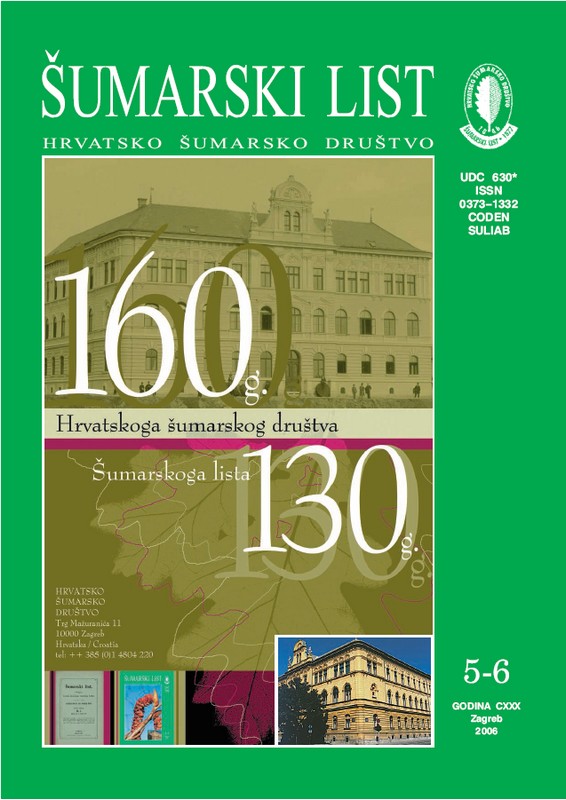
broj: 5-6/2006
pdf (30,9 MB) |
|
||||||||||||||
| IZVORNI ZNANSTVENI ČLANCI | ||
| CEROVEČKI, Zdravko | UDK 630* 188 (001) | |
| Seslerio sadlerianae-Ostryetum Cerovečki ass. nov. (Ostryo-Carpinion orientalis Ht. 1959) in the Mountains of the Northwestern Croatia pdf HR EN | 175 | |
| Bobinac, Martin | UDK 630* 242 (001) | |
| Effects of Thinning on the Increment of Trees in Different Biological Positions in i Middle-Aged Beech Stand pdf HR EN | 183 | |
| Summary: The participation and increment of trees in different biological positions (BP) were analyzed in a middle-aged stand of beech (Fagetum montanum nudum Jov. 53 = Dentario-Fagetum montanum) growing on deep acid brown soil on crystalline schist in three sample plots subjected to different silvicultural treatments. The results are based on breast diameter data and the assessment of biological position of trees at the end of 1994 and 2002. The analysis included sample plots in which selective thinning was performed in 1985 (PP-1), 1985 and 1994 (PP-2), and control sample plot (PP-3). At the end of 2002, (stand age 50-55), of the total number of trees in the sample plots, trees in BP-1 accounted for 23.9–27.8 %, in BP-2 for 4.6-12.7 % and in BP-3 for 61.8–71.6 %. Trees in the first biological position participated in the basal area increment with 81.0–88.0 %, and in the stand basal area with 64.5–68.1 %. Trees in the third biological position participated in the basal area increment with 5.0-9.0 % and in the stand basal area with 20.5–27.7 %. In the observed period, trees in BP-1 in thinned sample plots grew on average by 13.53–14.31 m3/ha annually and in the control plot by 11.03 m3/ha. Trees in BP-1 participated in the total volume increment in thinned plots with 82.0 %–89.0 % and in the control plot with 86.0 %. In relation to the trees in BP-3, the average annual increase in growth elements in BP-1 trees was as follows: breast diameter: 9.80–17.00 times, height: 2.63–3.75 times, basal area: 26.00-37.00 times, and volume: 26.30–40.01 times. Compared with PP-1 and the control plot (PP-3), an increase in growth elements was higher within PP-2. The results indicate different effects on the increment of the remaining trees in dependence on stand thinning intensity. Apart from a positive effect on the dominant trees, to a certain extent thinning also had positive effects on other biological categories of trees. However, this is a negligible productive effect in view of the fact that thinning at this stage of stand development is a necessary silvicultural intervention aimed at forming trees in the dominant storey and that thinning achieves the best effects on the increment of this tree category. The higher average increase in breast diameter, height, basal area, volume and the higher percentage of volume increment in trees in the first biological position, as well as their higher participation in the basal area increment and stand volume compared to other tree categories indicate that tending in young and middle-aged beech stands should primarily be targeted at trees in the dominant biological position. With timely application of high thinning, trees in BP-3 can assume an important biological-ecological role of “stabilizer” in stands. Key words: beech; biological position of trees; increment; middle-aged stand; selective thinning | ||
| PREGLEDNI ČLANCI | ||
| Schneider-Jacoby, Martin | UDK 630* 263 + 148.2 + 907.1 | |
| The Sava and Drava Floodplains: Threatened Ecosystems of International Importance pdf HR EN | 193 | |
| PRETHODNO PRIOPĆENJE | ||
| Dubravac, T., V. Krejči, B. Vrbek | UDK 630* 231 + 181 + 114.3 | |
| Structure and Development of a 161 Year-old Spruce Culture pdf HR EN | 219 | |


